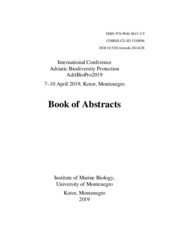| dc.description.abstract | Algae are an integral part of the aquarium and it is impossible to get rid of them com-pletely, most commonly they are unwanted phenomena. The increased concentration of phosphate and nitrates is responsible for the occurrence of excessive amounts of algae in aquariums. The appearance of algae is essentially influenced by the intensity of the light and the length of the aquarium's exposure to light. The research of the algae was carried out at the Center for Fishery and Biodiversity Conservation of Inland Waters - Aquarium Kragujevac, Faculty of Science. The survey covered a total of 18 aquariums (1 marine, 4 tropical and 13 coldwater). The periphyton from all aquariums, was collected by scraping from glass, stones, by pipette along the sand surface, at plants and corals (in marine aquar-ium). In the marine aquarium, algae have been successively developed and belonged taxa were from: Cyanobacteria, Rhodophyta, Xanthophyta, Bacillariophyta, Phaeophyta and Chlorophyta. Immediately behind forming in the marine aquarium Licmophora sp. was observed and after that Trichodesmium erythraeum (Ehr.) ex Gom. was dominant. It co-vers almost the entire bottom of the aquarium, as well as the surface of many corals. All algae have formed macroscopic aggregations on different types of substrates (Vaucheria litorea Hofman ex C. Ag., and Phymatoliton sp. ). The results of the algae analysis at tropical aquarium indicate the presence taxa from: Cyanobacteria, Bacillariophyta and Chlorophyta. The most dominant species in the period of investigation of tropical aquar-iums is Achnanthidium exiguum (Grun.) Czarn. Algae from the genus Oedogonium and Cladophora was also dominate next to the species from Bacillariophyta. In coldwater aquariums, there was a different situation, it was detected taxa from Cyanobacteria, Xan-thophyta, Bacillariophyta and Chlorophyta, but the most dominant taxa in the examined aquariums were Cyanobacteria. Algae in aquarium are an undesirable occurrence, if they have already appeared it could be removed by different methods (mechanical, biological and chemical). | sr |


